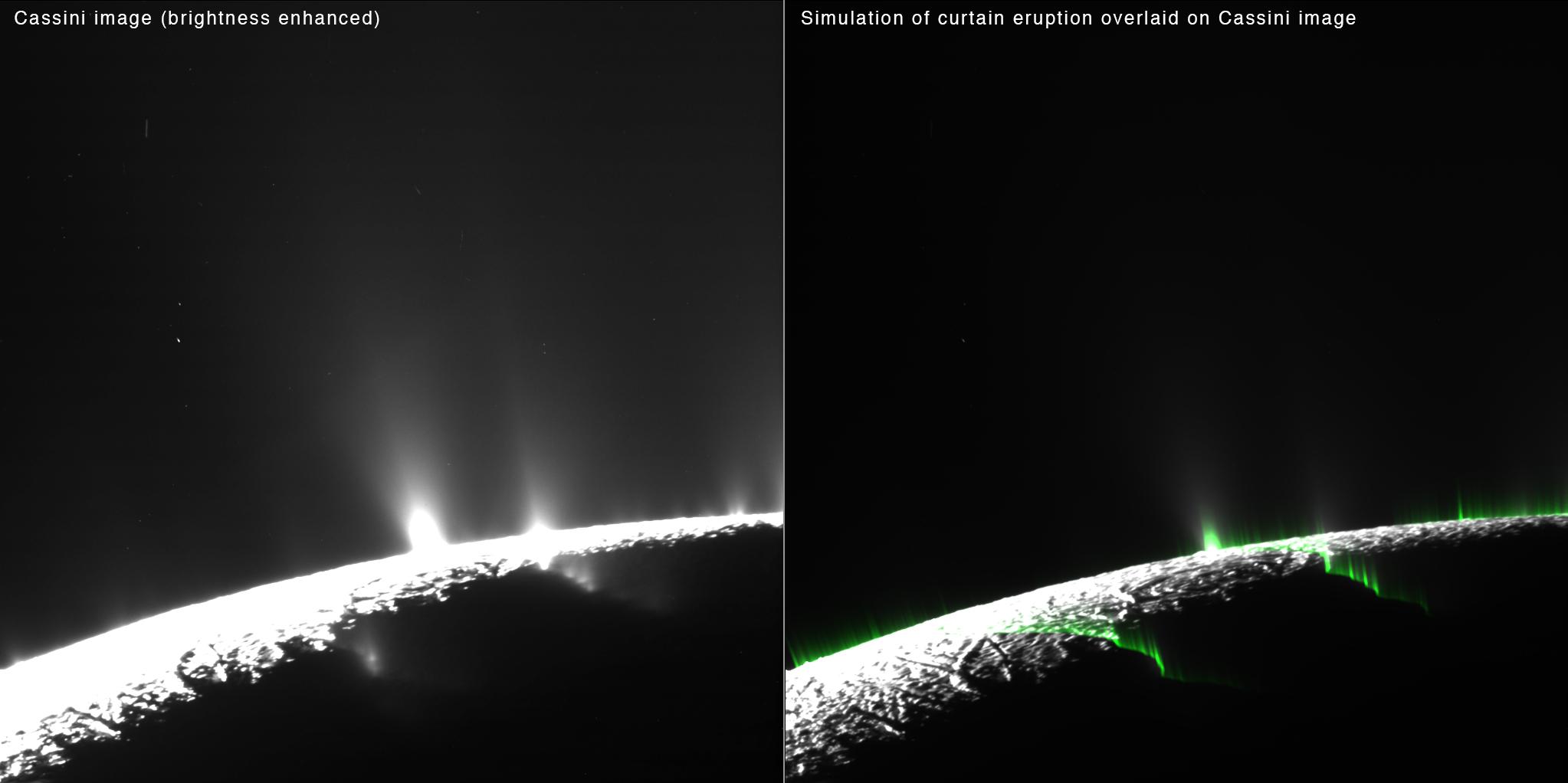'Jets' on Saturn Moon Enceladus May Actually Be Giant Walls of Vapor and Ice

Curtains of vapor and ice miles high and hundreds of miles long might erupt from rifts on Saturn's icy, ocean-harboring moon Enceladus, researchers say.
In fact, most of the seemingly discrete geysers seen on Enceladus until now may have just been optical illusions of these much broader "curtain" eruptions, the scientists said in the new study.
Enceladus is Saturn's sixth-largest moon, a 310-mile-wide (500 kilometers) satellite coated with an icy shell. Years ago, researchers had thought Enceladus was cold and geologically dead, but in 2005, NASA's Cassini spacecraft spotted water vapor and icy particles erupting from the moon. [See Enceladus' Curtain-like Jets in Action (Video)]

Scientists then determined that these outbursts originate from four "tiger stripes" — fractures on Enceladus' south pole named after the cities Alexandria, Baghdad, Cairo and Damascus. These explosions are fed by a network of cracks that may carry water up from a giant subsurface ocean.
Initially, planetary scientist Joseph Spitale, of the Planetary Science Institute in Tucson, Arizona, and his colleagues thought these eruptions were concentrated jets. But now, they've found that these explosions may actually be giant curtains of vapor and ice.
"A lot of things that looked like jets were optical illusions — they were really curtains," Spitale told Space.com.
The scientists analyzed Cassini images of what they thought were jets from Enceladus in order to determine where these eruptions come from and what might cause them.
Get the Space.com Newsletter
Breaking space news, the latest updates on rocket launches, skywatching events and more!
"What became evident very quickly was that a lot of the tiny little jets we looked at were real slippery — we couldn't triangulate them," Spitale said. "We also saw really broad areas of emissions that couldn't be jets — they were just huge fuzz."
So, how could the "curtains" be mistaken for focused jets? The fractures from which the curtains emerge often meander, Spitale said. This means that, instead of stretching in perfectly straight lines, the curtains can fold against one another. In places where these curtains bunch up, the eruptions of vapor and ice are denser, and can resemble jets, Spitale explained.
"This should have been obvious, but it was a big surprise to us," Spitale said.
In five snapshots of Enceladus taken during a one-year period across 2009 and 2010, "it looks like most of the time, most of the fractures are turned on," Spitale said. "They're emitting at some level all the time."
Spitale noted that Enceladus may still have concentrated jets of vapor and ice. "We're not saying that all of these eruptions are curtains," Spitale said. Jets might occur where fractures meet, or where debris falling into fractures has propped the cracks open, he suggested.
Future research can see when these curtain eruptions grow or shrink in strength. "We think tidal forces are influencing these eruptions — the gravitational pull of Saturn should be affecting the amount of stress on these fractures to open or close them," Spitale said.
The new study was published online today (May 6) in the journal Nature.
Follow us @Spacedotcom, Facebook or Google+. Originally published on Space.com.
Join our Space Forums to keep talking space on the latest missions, night sky and more! And if you have a news tip, correction or comment, let us know at: community@space.com.

Charles Q. Choi is a contributing writer for Space.com and Live Science. He covers all things human origins and astronomy as well as physics, animals and general science topics. Charles has a Master of Arts degree from the University of Missouri-Columbia, School of Journalism and a Bachelor of Arts degree from the University of South Florida. Charles has visited every continent on Earth, drinking rancid yak butter tea in Lhasa, snorkeling with sea lions in the Galapagos and even climbing an iceberg in Antarctica. Visit him at http://www.sciwriter.us









